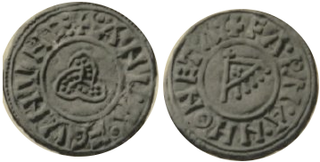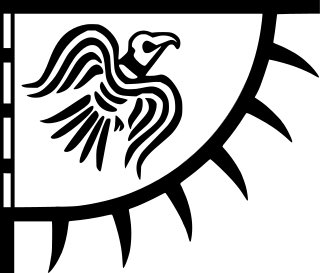This article needs additional citations for verification .(March 2016) |
This is a list of kings of Waterford.
This article needs additional citations for verification .(March 2016) |
This is a list of kings of Waterford.
The Vikings, who had created a longphort near Waterford in 853, finally settled and created a town in 914. These were led by Ottir Iarla. Ragnall ua Ímair then installed himself over them in 917, however leaving a year later for Britain, with Ottir, and presumably placing a deputy in control. Several of the 11th-century Norse kings, the descendants of Ímar (died 1000), were both allied to and vassals of the powerful O'Brien dynasty, with whom they may also have intermarried, and who in at least one case in the 1070s (Diarmait, son of Toirrdelbach Ua Briain) exercised direct rule over the small city.
The fate of the Waterford Norse is uncertain after the Norman invasion. Forced out of their own city, they are recorded occupying some of the surrounding countryside for a period afterwards. Also uncertain is how long the Uí Ímair continued to provide rulers.
This is a list of rulers of Waterford, nominal or otherwise, from the early Cambro-Norman period until the succession of mayors. While the first known charter was issued in 1205 by King John of England, the city had been declared to be a royal city by King Henry II of England in 1171. [1] It is known that Waterford had a Provost in 1195, so certainly there was a civil administration prior to the establishment of the mayoralty. [2] Source for information in this section:. [3]

Amlaíb mac Sitric, commonly called Amlaíb Cuarán, was a 10th-century Norse-Gael who was King of Northumbria and Dublin. His byname, cuarán, is usually translated as "sandal". His name appears in a variety of anglicized forms, including Olaf Cuaran, Anlaf Sihtricson and Olaf Sihtricson, particularly in relation to his short-lived rule in York. He was the last of the Uí Ímair to play a major part in the politics of the British Isles.

The history of Ireland 800–1169 covers the period in the history of Ireland from the first Viking raids to the Norman invasion. The first two centuries of this period are characterised by Viking raids and the subsequent Norse settlements along the coast. Viking ports were established at Dublin, Wexford, Waterford, Cork and Limerick, which became the first large towns in Ireland.
The Battle of Corbridge took place on the banks of the River Tyne near the village of Corbridge in Northumberland in the year 918.
Sitric Cáech or Sihtric Cáech or Sigtrygg Gále, was a Hiberno-Scandinavian Viking leader who ruled Dublin and then Viking Northumbria in the early 10th century. He was a grandson of Ímar and a member of the Uí Ímair. Sitric was most probably among those Vikings expelled from Dublin in 902, whereafter he may have ruled territory in the eastern Danelaw in England. In 917, he and his kinsman Ragnall ua Ímair sailed separate fleets to Ireland where they won several battles against local kings. Sitric successfully recaptured Dublin and established himself as king, while Ragnall returned to England to become King of Northumbria. In 919, Sitric won a victory at the Battle of Islandbridge over a coalition of local Irish kings who aimed to expel the Uí Ímair from Ireland. Six Irish kings were killed in the battle, including Niall Glúndub, overking of the Northern Uí Néill and High King of Ireland.

The Uí Ímair, also known as the Ivardynasty or Ivarids, was a Norse-Gael dynasty which ruled much of the Irish Sea region, the Kingdom of Dublin, the western coast of Scotland, including the Hebrides and some part of Northern England, from the mid 9th century.
The Battle of Confey or Cenn Fuait was a battle fought in Ireland in 917 between the Vikings of Dublin and the Irish King of Leinster, Augaire mac Ailella. It led to the recapture of Dublin by the Norse dynasty that had been expelled from the city fifteen years earlier by Augaire's predecessor, Cerball mac Muirecáin of Uí Fáeláin, and his ally Máel Finnia mac Flannacáin, the King of Brega.
Ragnall mac Bárid ua Ímair or Rægnald was a Viking leader who ruled Northumbria and the Isle of Man in the early 10th century. He was a grandson of Ímar and a member of the Uí Ímair. Ragnall was most probably among those Vikings expelled from Dublin in 902, whereafter he may have ruled territory in southern Scotland or the Isle of Man. In 917, he and his kinsman Sitric Cáech sailed separate fleets to Ireland where they won several battles against local kings. Sitric successfully recaptured Dublin and established himself as king, while Ragnall returned to England. He fought against Constantín mac Áeda, King of Scotland, in the Battle of Corbridge in 918, and although the battle was not decisive it did allow Ragnall to establish himself as king at York.
Gofraid ua Ímair or Guthfrith of Ivar was a Hiberno-Scandinavian and Viking leader who ruled Dublin and briefly Viking Northumbria in the early 10th century. He was a grandson of Ímar and a member of the Uí Ímair. Gofraid was most probably among those Vikings expelled from Dublin in 902, whereafter he helped his kinsman Ragnall conquer Northumbria. Another kinsman, Sitric Cáech, became ruler of Dublin around the same time. Ragnall died in 920, and so the following year Sitric left Dublin to rule in Northumbria, and Gofraid succeeded Sitric as ruler of Dublin. Sitric's early reign was marked by raids he conducted against the Gaelic (Native-Irish), including one at Armagh.
Gofraid mac Arailt, in Old Norse Guðrøðr Haraldsson[ˈɡuðˌrøðz̠ ˈhɑrˌɑldsˌson], was a Scandinavian or Norse-Gael king. He and his brother Maccus were active in the lands around the Irish Sea in the 970s and 980s.
Events from the 10th century in Ireland.
Ivar of Limerick, was the last Norse king of the city-state of Limerick, and penultimate King of the Foreigners of Munster, reigning during the rise to power of the Dál gCais and the fall of the Eóganachta.

Ivar of Waterford was the Norse king of Waterford from at least 969 until his death in the year 1000, and also reigned as King of Dublin, possibly from 989 to 993, and certainly again for less than a year between 994 and 995, returning after his expulsion from the city in 993 by Sigtrygg Silkbeard, who would expel him for good the next time.
Earl Ottir, also known as Ottir the Black, was a jarl who occupied a prominent position among the Norse of Britain and Ireland in the early 10th century. He is believed to be the founder of the settlement, Veðrafjǫrðr in the year 914. From 917 to his death in 918 Ottir was a close associate of the powerful overking Ragnall ua Ímair, although they are not known to have been related.
Ragnall, Raghnall, Raonall, and Raonull are masculine personal names or given names in several Gaelic languages.

Ragnall Guthfrithson was a Viking leader who ruled Viking Yorkshire in the 10th century. He was the son of Gofraid ua Ímair and great-grandson of Ímar, making him one of the Uí Ímair. He ruled Northumbria in 943 and 944, either with, or in opposition to, Olaf Cuaran. Ragnall and Olaf were driven out of Northumbria by the English in 944. His later life is unknown but it is possible he was the "king of the Danes" who is reported as being killed by the Saxons at York in 944 or 945.
Ímar mac Bárid ; also known as Ivar II, was a Norse-Gaelic King of Dublin. He was a grandson of Ivar Gudrödrødsson and a member of the powerful Uí Ímair.
The Battle of Islandbridge, also called the Battle of Áth Cliath, took place on 14 September 919, between a coalition of native Irish, led by Niall Glúndub, overking of the Northern Uí Néill and High King of Ireland, and the Dublin-based Vikings of the Uí Ímair, led by Sitric Cáech. It was one in a series of battles initiated by the native Irish to attempt to drive the Vikings of the Uí Ímair from Ireland. The battle was a decisive victory for Sitric Cáech and the Uí Ímair, with Niall Glúndub and five other Irish kings dying in the battle.
The Battle of Mag Femen took place on 22 August 917 between the Vikings of the Uí Ímair, led by Ragnall, a grandson of Ímar, and the Irish of the Northern Uí Néill, led by Niall Glúndub, High King of Ireland. It was one of two battles involving the Uí Ímair that year, the other being the Battle of Confey, which occurred as a result of the Uí Ímair trying to retake the Kingdom of Dublin, lost by them in 902. The battle began when Niall Glúndub's forces attacked a Viking army at a site identified by the annals as Topar Glethrach in Mag Femen. The Irish initially inflicted the majority of the casualties, but late in the day a host of more troops led by Ragnall reinforced the Viking army, securing victory for the Uí Ímair.
Colla mac Báirid or Colla ua Báirid was a Viking leader who ruled Limerick in the early 10th century. He first appears in contemporary annals in 924 when he is recorded as leading a raiding fleet to Lough Ree. He appears in the annals for the second and final time in 932 when his death his recorded. In both of these instances he is titled king of Limerick. Colla's parentage is uncertain; according to one theory he was the son or grandson of Bárid mac Ímair, a Uí Ímair king of Dublin, and according to another he was the son of Bárid mac Oitir.
Ragnall ua Ímair, also known as Ragnall mac Ragnaill, was an eleventh-century King of Waterford. He appears to have ruled as king from 1022 to 1035, the year of his death.